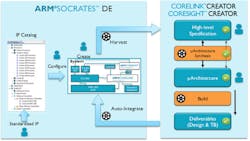ARM has released a new set of tools designed to streamline the process of building silicon with one or more Cortex cores (see the figure). The tools include ARM Socrates Design Environment (DE), Corelink Creator, and Coresight Creator.
It used to take months to turn ARM IP into a product and that is assuming a relatively easy integration with third-party IP. The new tools look to cut this process to a few days with basic system design started within an afternoon.
The starting point is ARM Socrates DE and its IP Catalog. This includes the usual ARM IP, including Cortex CPU cores as well as GPU cores. The catalog uses IEEE standard IP formats allowing third-party IP to be included. Design-rule checks (DRC) help validate the design during system construction. DRC support means automatically generated RTL and design specifications will work.
Part of the challenge for larger designs is coming up with something that can actually meet all the design constraints, including power and timing.
ARM Corelink Creator provides the interconnect between cores and IP. This can be relatively simple for a single core and a few peripherals or a more complex environment designed to support multiple CPUs, GPUs, DMAs, and so on. It supports the NIC-450 hierarchy of NIC-400 interconnects delivering a deadlock-free system. It can also handle multiple power and voltage domains that are common on large and small systems.
The final piece to the puzzle is provided by ARM Coresight Creator. Coresight is the debug support found in most Cortex-based microcontrollers and microprocessors. The debug and trace support can vary and Coresight Creator allows developers to select and configure the on-chip tools they desire. The process was complex because often hundreds of registers and interface ports needed to linked by hand. Changes were time-consuming and error-prone. Coresight Creator automates this process, reducing time to market and providing an error-free debug design.
About the Author
William G. Wong
Senior Content Director - Electronic Design and Microwaves & RF
I am Editor of Electronic Design focusing on embedded, software, and systems. As Senior Content Director, I also manage Microwaves & RF and I work with a great team of editors to provide engineers, programmers, developers and technical managers with interesting and useful articles and videos on a regular basis. Check out our free newsletters to see the latest content.
You can send press releases for new products for possible coverage on the website. I am also interested in receiving contributed articles for publishing on our website. Use our template and send to me along with a signed release form.
Check out my blog, AltEmbedded on Electronic Design, as well as his latest articles on this site that are listed below.
You can visit my social media via these links:
- AltEmbedded on Electronic Design
- Bill Wong on Facebook
- @AltEmbedded on Twitter
- Bill Wong on LinkedIn
I earned a Bachelor of Electrical Engineering at the Georgia Institute of Technology and a Masters in Computer Science from Rutgers University. I still do a bit of programming using everything from C and C++ to Rust and Ada/SPARK. I do a bit of PHP programming for Drupal websites. I have posted a few Drupal modules.
I still get a hand on software and electronic hardware. Some of this can be found on our Kit Close-Up video series. You can also see me on many of our TechXchange Talk videos. I am interested in a range of projects from robotics to artificial intelligence.

